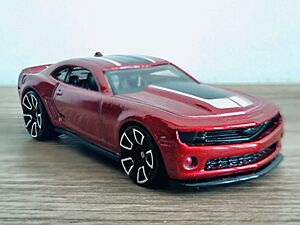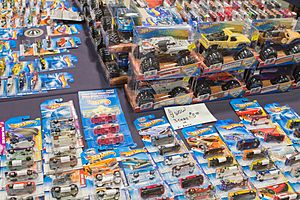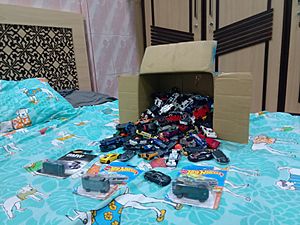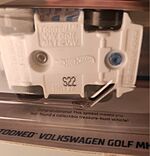Hot Wheels facts for kids
 |
|
| Type | Scale model cars, racing tracks |
|---|---|
| Owner | Mattel |
| Country | United States |
| Introduced | May 18, 1968 |
| Markets | Worldwide |
Hot Wheels is a famous American brand of toy cars and racing tracks. It was created by Elliot Handler and launched by his company Mattel on May 18, 1968. For many years, Hot Wheels was the main rival to another popular toy car brand, Matchbox, until Mattel bought Matchbox's owner in 1997.
Many real car companies have given Hot Wheels permission to make small versions of their cars. This means Hot Wheels can use the original designs and details. Even though Hot Wheels were first made for kids, they are now very popular with adult collectors. Special limited edition models are even made just for them.
Contents
History of Hot Wheels
How Hot Wheels Started
In the late 1960s, Elliot Handler, who helped start Mattel, had an idea for a new toy line. He wanted to create cars that boys would love, just like girls loved their Barbie dolls. Handler got the idea after watching his son, Kenneth, play with Matchbox cars.
Unlike Matchbox cars, which looked like real cars, Handler imagined Hot Wheels as cool, customized "hot rod" cars. They would have big back tires, superchargers, flame paint jobs, and wild shapes. He started making these cars with help from engineer Jack Ryan. The famous flame logo was designed by artist Rick Irons. Mattel first showed off 16 Hot Wheels cars at the New York Toy Fair in 1968.
The Original Sweet 16 Cars
The very first Hot Wheels cars, known as The Original Sweet 16, were made in 1967. These cars were part of the "Red Line Series" because their tires had a red stripe on the sides.
There were sixteen different car designs released. Eleven of these were designed by Harry Bentley Bradley. The first car made was a dark blue "Custom Camaro". Bradley had worked in the car industry and designed real cars like the Dodge Deora.
The first 16 cars included:
- Beatnik Bandit
- Custom El Dorado
- Custom Camaro
- Custom Corvette
- Custom Fleetside
- Deora
- Custom Mustang
- Custom T-Bird
- Hot Heap
- Ford J-Car
- Custom Cougar
- Custom Firebird
- Custom Barracuda
- Python
- Silhouette
- Custom Volkswagen
Hot Wheels Racing Tracks
Mattel also made racing track sets that were sold separately. The original track sets had bright orange road sections that could be put together to make a circular race track. They often included "superchargers," which were like fake gas stations with battery-powered spinning wheels. These wheels would push the cars along the track.
Hot Wheels cars had wide, hard-plastic tires that created less friction. This made them roll much smoother and faster than other toy cars at the time. This was a big new idea!
The "Redline" Era (1968–1977)
The Hot Wheels brand was a huge success right away. It completely changed the toy car industry from 1968 onwards. Other companies like Matchbox had to quickly change their own designs to keep up. Harry Bentley Bradley, the original designer, left Mattel. So, Mattel hired his friend, Ira Gilford, who had worked for Chrysler. Gilford designed some of Hot Wheels' most famous cars, like the Twin Mill and Splittin' Image. The Twin Mill was even made into a real, full-size car in 2001.
The success continued in 1969, making Hot Wheels the most popular toy car brand in the USA. Cars like Splittin' Image, Torero, Turbofire, and Twin Mill were the first original designs made entirely by Hot Wheels.
An early design for the Beach Bomb car was based on a real VW bus. It had two surfboards sticking out the back window. However, this version was too narrow and top-heavy to work well on Hot Wheels tracks. Designers Howard Rees and Larry Wood changed the car, making its sides wider and moving the surfboards to the side. They also cut away the roof and added a sunroof to make it more stable. This changed version was the one sold in stores.
The original Rear-Loader Beach Bomb is now extremely rare and valuable to collectors. Only a few were made as test models and given to employees. A regular Beach Bomb can be worth up to $600, but the rare Rear-Loader Beach Bomb can sell for tens of thousands of dollars. The Petersen Automotive Museum in Los Angeles even has a pink one on display.
The 1970s
1970 was another great year for Hot Wheels. Mattel came up with a new slogan: "Go With the Winner." They released 43 new cars, including the Sizzlers and Heavyweights lines. Larry Wood, another designer, joined Mattel and designed many popular cars, including the Tri-Baby. He retired in 2019 after over 40 years.
Another designer, Paul Tam, created cars like Evil Weevil (a Volkswagen Beetle with two engines) and Open Fire (an AMC Gremlin with six wheels).
In 1970, Hot Wheels also sponsored two famous drag racers, Don "the Snake" Prudhomme and Tom "the Mongoose" McEwen. This helped make drag racing more popular. Hot Wheels also released special silver-painted cars that year, which were only available by mail.
However, 1972 and 1973 were slower years for Hot Wheels. They made fewer new models, and the cars changed from shiny Spectraflame colors to duller, solid enamel colors. Because fewer of these cars were made, they are now very collectible.
In 1974, Hot Wheels introduced its 'Flying Colors' line. These cars had bright decals and printed designs, which helped boost sales. This idea was also copied by other toy car companies.
In 1977, the red lines on the wheels were removed to save costs. This also reflected a change in real car trends, as red line tires were no longer as popular. Hot Wheels also started making more realistic cars and trucks, similar to Matchbox.
The 'Blackwalls' Era (1977–1988)
In the 1980s, Hot Wheels introduced new wheel styles like Hot Ones (with gold hubs) and Ultra Hots (with thin axles for more speed). They also started making models of 1980s sports and economy cars. In 1983, Real Riders wheels with real rubber tires were introduced, but they were expensive to make and didn't last long.
In the late 1980s, the blue packaging for Hot Wheels cars became common. This design is still used today. Two other cool features were added briefly: Thermal Color Change paint, which changed color in hot or cold water, and Crack-Ups cars, which had panels that would dent when hit.
Hot Wheels had a small issue with General Motors in the 1980s. Hot Wheels made a toy version of the new 1984 C4 Corvette before GM officially showed the real car. GM was not happy, but it also created a lot of excitement for the new Corvette.
In 1985, Hot Wheels even released a computer game for various old computer systems.
The Collector Number Era (1989–1994)
In 1989, Mattel started giving each Hot Wheels car a collector number. All the cars came in blue packaging. The numbers went up to 274, but some numbers were skipped.
The Treasure Hunt Era (1995–1999)
In 1995, Hot Wheels cars were organized into different series. The "First Editions" series included all the new car designs for that year. Also, the special Treasure Hunt Series was introduced. Other series had four cars with similar paint themes, like the Pearl Driver cars with shiny, pearlescent paint. Sales went up, and stores sometimes ran out of cars.
In 1997, Mattel bought Tyco Toys, which owned Matchbox. This meant the two biggest toy car companies were now part of the same family.
In 1998, Hot Wheels celebrated its 30th anniversary by making copies of old cars and packaging from its history. In 1999, "Hot Wheels Interactive" was launched.
The 2000s
New designers joined the Hot Wheels team, including Eric Tscherne, Fraser Campbell, and Alec Tam. Eric Tscherne's Seared Tuner car was featured on the main packaging from 2000 to 2003. The Deora II, one of only two Hot Wheels concept cars ever built as a real, working car, was also released this year.
In 2001, Mattel launched a website for Hot Wheels collectors. That year, they released 240 different cars, including 12 Treasure Hunts and 36 First Editions.
In 2003, Hot Wheels celebrated its 35th anniversary with an animated movie called Hot Wheels Highway 35 World Race. This movie was connected to a line of 35 classic Hot Wheels cars with special designs.
In 2004, Hot Wheels introduced 100 new models, many of which were cartoon-like vehicles such as Tooned (cars with exaggerated features) and Blings (boxy cars with big wheels). These didn't sell as well as Mattel hoped.
In 2005, Hot Wheels continued with new "extreme" car designs. They also launched the "Faster than Ever" line, which had special nickel-plated axles and bronze wheels to reduce friction and make the cars go faster.
A sequel to the Highway 35 movie, called Hot Wheels AcceleRacers, was also released. It included four movies and many short videos.
2006 was the last year for the "First Editions" series. It included 38 cars, both real car models like the Toyota AE86 and fantasy models like the popular Bone Shaker, designed by Larry Wood.
In 2007, Mattel changed how they organized their car releases. They introduced "New Models" (formerly First Editions) and "Super Treasure Hunts," which were much harder to find and had special paint and rubber tires. They also released a series called Modifighters, which were cars that could change into robots.
From 2008 to 2009, Hot Wheels continued to release many new vehicles and series. In 2009, Mattel also launched its first animated TV show, Hot Wheels Battle Force 5, which aired on Cartoon Network.
The 2010s
In 2011, 244 cars were released, including new models like the Lamborghini Gallardo LP570-4 Superleggera and the DeLorean time machine from Back to the Future.
2012 saw 247 new cars, including the Lamborghini Aventador, KITT from Knight Rider, and the Scooby-Doo Mystery Machine. They also released cars based on the Angry Birds video game.
In 2013, 250 cars were released, and the packaging cards got a new look. The Treasure Hunt series cards no longer had a treasure chest symbol.
General Motors also released a special Chevrolet Camaro Hot Wheels Edition, a blue convertible with Hot Wheels decorations.
In 2014, Hot Wheels released 250 cars. This year also marked the end of Mattel's agreement with Ferrari, meaning the 2014 Ferrari 5 Pack and the 2015 Ferrari 599XX were the last Ferrari models from Hot Wheels for a while.
The 2016 lineup had similar car segments, but the card design was updated. New models included the Cruise Bruiser and the '16 Acura NSX.
The 2017s and Beyond
In 2017, Hot Wheels changed how they numbered their cars. Now, different colors of the same car design get different numbers, increasing the total number of cars released each year to 365. New series like Experimotors (cars with moving parts) and Camaro Fifty (celebrating the Chevrolet Camaro's 50th anniversary) were introduced.
In 2018, Hot Wheels celebrated its 50th anniversary. The car packaging changed again, showing a city in the background. Each card also had a 50th Anniversary logo. Hot Wheels also launched special collector lines, like Favorites, which had highly detailed real cars with metal bodies and rubber tires. They also released a display case that could hold 48 cars.
In 2019, a new motto, it's not the same without the flame, was added to the packaging.
On February 18, 2021, Hot Wheels released a toy version of the NASA Perseverance rover that landed on Mars. Sadly, Hot Wheels designer Ryu Asada passed away on March 23, 2021. That same year, Hot Wheels partnered with Milestone S.r.l. to release their first video game, Hot Wheels Unleashed, on September 30, 2021.
More recently, on March 7, 2023, NBC ordered a reality TV show called Hot Wheels: Ultimate Challenge, which started on May 30, 2023. On September 28, 2023, Netflix announced a new animated series, Hot Wheels Let's Race, which premiered on March 4, 2024. And on October 9, 2024, Formula One announced a new partnership with Hot Wheels, with a special F1 car released in 2024 and a full range of F1 products coming in 2025.
Hot Wheels Legends Tour
In 2018, Hot Wheels started the Hot Wheels Legends Tour to celebrate its 50th anniversary. Each year, events are held at Walmart stores across the United States. Thousands of people attend, and many custom cars are entered. At each event, one car is chosen to be made into a potential new Hot Wheels toy. After all the events, one final winner is picked, and their car becomes a new Hot Wheels casting the next year. Hot Wheels looks for cars that show the fun and creative spirit of the brand.
Hot Wheels Legends Tour Winners
- 2018: Custom built "2JetZ", by Luis Rodriguez
- 2019: 1957 Nash Metropolitan "The Nash", by Greg Salzillo and Dave Ford
- 2020: 1970 Pontiac Trans Am, by Riley Stair.
- 2021: 1969 Volvo P1800 "Ain't No Saint", by Lee Johnstone.
- 2022: 1992 Autozam Scrum "Texas Toot", by Craig Meaux
- 2023: 1990 Mazda MX-5 Roadster "Chimera", by Chris Watson
- 2024: Custom 1968 Ford Falcon "La Liebre", by Giuseppe Casagrande and Maurizio Moschini
Collecting Hot Wheels
For many years, mostly children collected Hot Wheels cars. But since the late 1990s, more and more adults have started collecting them too. Mattel estimates that 41 million children have played with Hot Wheels. The average adult collector owns over 1,550 cars, and kids between 5 and 15 years old have about 41 cars. Many believe the collecting craze really took off with the Treasure Hunts in 1995.
Mike Strauss is often called the "father of Hot Wheels collecting." He has organized collector events since 1986. He also published the Hot Wheels Newsletter and wrote Tomart's Price Guide To Hot Wheels, a book that helps collectors learn about the cars and their value.
Collecting Hot Wheels can be a fun and affordable hobby. Mainline cars usually cost around $1.00 at stores. This price hasn't changed much in over 40 years, even with inflation. However, once cars are no longer sold in stores, their value can change a lot. A common car might sell for less than its original price, while rare cars can sell for hundreds or even thousands of dollars. The highest price ever paid for a Hot Wheels car was nearly $70,000 in 2000 for a very rare pre-production Volkswagen Rear Loader Beach Bomb. This car was a VW microbus with surfboards sticking out the back window. Only about 50 of these rare "rear loaders" are known to exist.
Dates on Hot Wheels Cars
The date you see on the bottom of a Hot Wheels car (like ©2008 Mattel) is the copyright date for the car's design, not when it was made or first sold. This date is usually the year before the car was first released, but not always. For example, a car released in 2001 might have a 2000 copyright date. The copyright date usually stays the same throughout the car's life. If a car's design changes a lot, the copyright date might be updated.
Since 2008, Hot Wheels cars also have a "base code" stamped on the bottom. This code tells you exactly when the car was made in the factory. It starts with a letter (like "A" for 2008) followed by two numbers. The numbers show the week of that year the car was made. For example, "A52" means the car was made in the 52nd week of 2008. Some cars have a 4-digit code that shows the exact day it was made.
These date codes tell you when a specific car was produced, but not necessarily its model release year. New model year cars usually start being produced around the middle of the calendar year.
Hot Wheels Classics
The Hot Wheels Classics line was very popular with collectors. This series focused on muscle cars, hot rods, and other unique vehicles, many from Hot Wheels' early years (1968–1978). The series also introduced new car designs.
Series 1, released in 2005, had 25 models. Each car had a metal body and chassis, shiny Spectraflame paint, and came in packaging similar to the original 1968-1972 designs. These cars cost about $3-4 each and came in 7 or 8 different colors. Popular models included the 1957 Chevy Bel Air and the 1965 Pontiac GTO. There were also matching track sets and larger 1:18 scale Hot Wheels Classics.
Series 2, released in late 2005, had 30 models, including the 1967 Camaro Convertible and the 1969 Dodge Charger. In 2006, Series 3 also had 30 models, like the '69 Pontiac Firebird and the Richard Petty '70 Plymouth "Superbird".
In 2007, Series 4 had 15 models. For Hot Wheels' 40th anniversary in 2008, they made a special diamond-studded car worth $140,000 to celebrate making their four billionth car! It had 2,700 diamonds and was made of white gold with rubies for taillights.
Series 5 in 2009 had 30 models and introduced "chase cars" with real rubber tires.
Special Hot Wheels Lines
Hot Wheels has also made larger, more detailed models, like the original Gran Toros (1/43 scale) from 1970 and the Dropstars line of "blinged" cars. They also produced models in standard scales like 1/43, 1/24, and 1/18. In 2004, they even released a 1/12 scale replica of the C6 Corvette.
In the early 1990s, Hot Wheels introduced the California Customs, a line of cars with a California theme. Other lines have included R-R-Rumblers & Chopcycles (motorcycles), Hotbirds (metal airplanes), and Sizzlers.
Over the years, Mattel has partnered with many stores and companies to create special Hot Wheels models. These partners include Avon, Chuck E. Cheese, McDonald's, Target, Toys "R" Us, and Walmart, among many others.
In 2016, Hot Wheels released a special collection for the 50th anniversary of The Beatles' song "Yellow Submarine." This collection included five cars, a VW microbus, and a yellow submarine.
Hot Wheels Elite and Hot Wheels Mattel
Hot Wheels has a special series called Hot Wheels Elite. These are highly detailed diecast models, mostly of Ferraris, in scales like 1:18 and 1:43. They are more expensive than the regular Mattel models because of their extra detail. The Elite versions are officially licensed by Ferrari.
Car Culture Series
In 2016, Hot Wheels started a new line for collectors called Car Culture. These are premium 1:64 scale models with metal bodies and bases, two-piece wheels with rubber tires, and more detailed designs. They are made for adult collectors and cost more than regular Hot Wheels cars.
The first Car Culture set was "Japan Historics", featuring five Japanese sports cars. Each year, at least four more sets are released, usually with five cars based on real automobiles. In 2018, Hot Wheels also introduced "Team Transport" sets, which include a car and a matching truck.
The Treasure Hunt Series
The Treasure Hunt (or T-Hunt) is a special line of Hot Wheels cars that Mattel started in 1995. Each year, there are 12 (or 15 since 2011) of these cars. They were originally made in limited numbers, but production has increased due to high demand from collectors.
You can spot a Treasure Hunt car by a circle flame logo on the car itself and on the card behind the car. Before 2013, the packaging also had a green bar that said "Treasure Hunt" or "T-Hunt." These cars used to have special designs and "rubber" wheels before 2007.
In 2007, Mattel introduced two types of Treasure Hunts:
- Regular Treasure Hunts: These have normal paint and wheels, like other Hot Wheels cars.
- Super Treasure Hunts: These are much harder to find. They have premium wheels, shiny Spectraflame paint, and (since 2015) a gold circle-flame logo on the card.
Hot Wheels aims the Treasure Hunt series at both kids and adults, but the Super Treasure Hunts are mostly for adult collectors.
Hot Wheels Movies and Shows
Over the years, there have been plans for movies based on Hot Wheels. In 2003, Columbia Pictures announced a film, but it didn't happen. In 2009, the rights went to Warner Bros. Pictures. Various directors and writers were attached to the project over the years.
In late January 2019, Mattel Films and Warner Bros. Pictures officially partnered for a Hot Wheels movie. As of July 2025, Jon M. Chu is set to direct the film, with writers Dalton Leeb, Nicholas Jacobson-Larson, Juel Taylor, and Tony Rettenmaier working on the script.
Sizzlers: Motorized Hot Wheels
The Sizzlers were a popular Hot Wheels spin-off from the 1970s. These cars had a small built-in motor and a tiny rechargeable battery. They were introduced in 1970 and became very popular. Sizzlers could run on regular orange Hot Wheels tracks, and Mattel even made special race sets with loops and spirals just for them. They also created the black Fat Track, which was wider and designed for Sizzlers to race side-by-side.
Six Sizzlers cars were made in 1970, and more were released in 1971 and 1972. The "Fat Daddy" Sizzlers with oversized bodies came out in 1973. Mattel stopped making Sizzlers for a few years but brought them back as Sizzlers II in 1976 and Night Ridin' Sizzlers (with working headlights) in 1977. Production stopped permanently in 1978.
Sizzlers were charged using devices like the Juice Machine (which used D batteries) or the Power Pit (which plugged into a wall outlet). A quick 90-second charge could give up to five minutes of playtime.
In the 1990s, another company briefly re-released Sizzlers, but Mattel later brought them back themselves in 2006 for Target stores, complete with original packaging. In 2011, Sizzlers were re-released as Cars 2 characters, called Charge Ups.
Hot Wheels in Sports and Games
Motorsports Sponsorships
Hot Wheels has a long history of sponsoring real race cars. Starting in 1970, they sponsored professional drag racers Don Prudhomme ("The Snake") and Tom McEwen ("The Mongoose"). Hot Wheels even made a Snake and Mongoose Drag Set toy.
Hot Wheels has also sponsored cars in other racing series, including Trans-Am Series cars in 1970 and 1992, and NASCAR cars for drivers like Kyle Petty and Danica Patrick. In 1999, Hot Wheels partnered with Formula One teams to make toy F1 cars. In 2024, Formula One announced a new partnership with Hot Wheels, with new F1 cars and products coming in 2025.
From 1999 to 2018, Hot Wheels had a license with Monster Jam to make monster truck toys and even had a Hot Wheels-themed truck in real shows. After this partnership ended, Hot Wheels started its own Hot Wheels Monster Trucks line and live show.
Video Games Featuring Hot Wheels
Many video games based on Hot Wheels have been released for various game consoles, PCs, and mobile devices over the years. Some popular titles include:
- Hot Wheels Stunt Track Driver (1998)
- Hot Wheels Turbo Racing (1999)
- Hot Wheels Velocity X (2002)
- Hot Wheels: World Race (2003)
- Hot Wheels: Beat That! (2007)
- Forza Horizon 3: Hot Wheels (2017), an expansion pack for the racing game Forza Horizon 3.
- Hot Wheels Unleashed (2021), a popular racing game released for many platforms.
- Forza Horizon 5: Hot Wheels (2022), another expansion pack for Forza Horizon 5.
Pinball
A coin-operated pinball machine based on Hot Wheels cars and the Hot Wheels City YouTube series was released in June 2020.
Images for kids
See also
 In Spanish: Hot Wheels para niños
In Spanish: Hot Wheels para niños





